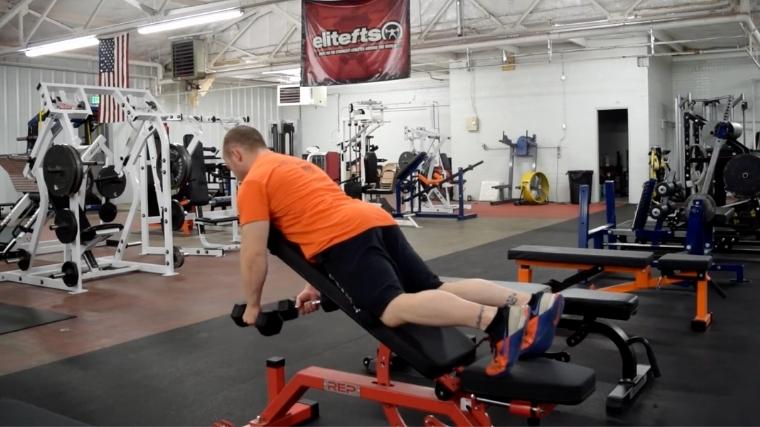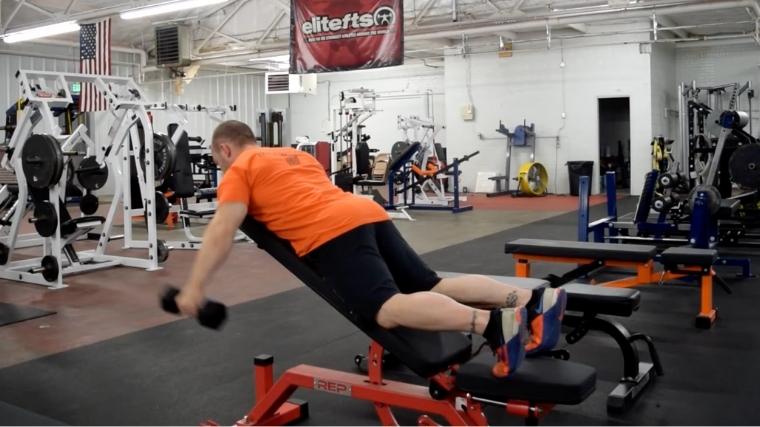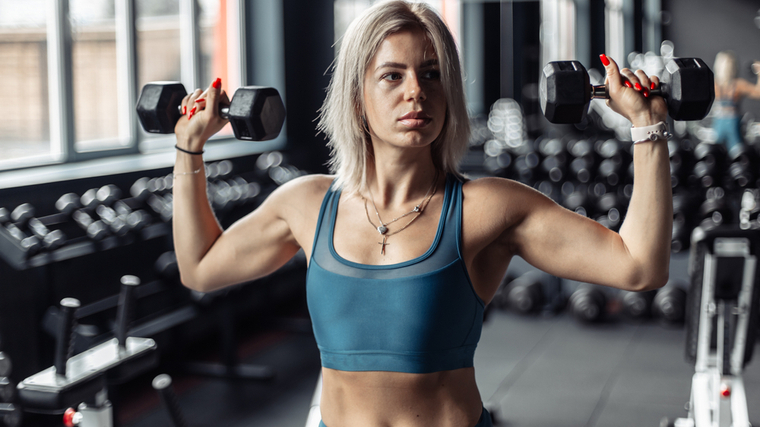The dumbbell rear lateral raise is an isolated movement that many lifters use to help build themselves “boulder shoulders.” It increases shoulder hypertrophy by engaging one of the smallest — and often neglected — muscles in the shoulder, the rear deltoid. But making sure your posterior (rear) shoulders are healthy and strong doesn’t only help your shoulders pop through your shirt. You’ll also improve pressing and pulling performances in powerlifting, weightlifting, and functional fitness moves.

All you’ll need is a pair of dumbbells to add this little exercise and make a big difference in your program. And lest it seem like a waste of time to isolate such a small muscle, it’s important to note that this is a key exercise even when overall strength is your primary goal. Building strong rear delts can help prevent asymmetries that may lead to injuries. It does so by giving your upper body the balance it needs to stay healthy during lifts as big and broad as the bench press, snatch, and deadlift. This article will teach you how to reap all these benefits — and more — from the dumbbell rear lateral raise..
- How to Do the Dumbbell Rear Lateral Raise
- Benefits of the Dumbbell Rear Lateral Raise
- Muscles Worked by the Dumbbell Rear Lateral Raise
- Who Should Do the Dumbbell Rear Lateral Raise
- Dumbbell Rear Lateral Raise Sets and Reps
- Dumbbell Rear Lateral Raise Variations
- Dumbbell Rear Lateral Raises Alternatives
- Frequently Asked Questions
How to Do the Dumbbell Rear Lateral Raise
Many people perform the dumbbell rear lateral raise in a bent-over stance. That’s all well and good if you’re certain you’ve got your form locked in. But if you want to perform this move with slightly heavier weights and perfect form for maximum results, try the chest-supported variation. That’s the variation that this guide will describe, as it often forces better technique and more isolation, especially as your muscles get fatigued.
Step 1 — Lie Down on an Incline Bench
Set up an incline bench on its lowest setting. Lie face down on the bench, with your upper chest and shoulders over the edge of the bench.

Coach’s Tip: Try not to arch your back too much. Allow your body to remain on the bench at all times.
Step 2 — Arms Out, and Lift Slowly
Reach your arms to the floor. Turn your thumbs towards each other with your hands pronated. Lift your arms outwards and slightly forward, engaging your rear delts. Maintain a soft to generous bend in your elbows.

Coach’s Tip: Lift as high as you can go with good form and no momentum. Don’t allow your shoulders to roll forwards or upwards towards your ears.
Step 3 — Lower Slowly, and Keep Tension on Muscle
Slowly lower your hands. Don’t allow gravity to pull them down quickly. If you are using too much weight, the weights will rush down quickly. Adjust the load accordingly.

Coach’s Tip: Use light weights. It does not take a lot of weight (often, much less than you would think) to effectively target the rear delts and build muscle.
Benefits of the Dumbbell Rear Lateral Raise
Even though it’s an isolation exercise, the dumbbell rear lateral raise comes with some pretty hefty benefits. From improved injury resilience to a broader shoulder aesthetic and strength gains, this little lift goes a long way.
Build Bigger Rear Delts
The dumbbell rear lateral raise is a great isolation exercise to target the rear deltoids. While these muscles are often trained and developed while doing overhead presses, rows, pulldowns, and most upper body movements, adding in isolation raises challenges your rear delts directly. Since these muscles don’t get direct stimulation from bigger compound movements, isolating them will round out your training — and your shoulders.
Improve Posterior Shoulder Health
Most people do a ton of pressing exercises. And while that’s excellent for shoulder development, shoulder pulling motions are often neglected. The best programs will make sure to address shoulder imbalances and develop better posterior shoulder strength. That way, your shoulders can remain strong, balanced, and healthy.
When your shoulder strength is more balanced, you’re less likely to develop potentially injury-inducing compensation patterns in your movements. For that reason, integrating dumbbell rear lateral raises into your training program is a great way to build stronger, healthier shoulders.
Strengthen Compound Lifts
When your rear delts are bigger and stronger — not to mention healthier — your compound lifts are sure to benefit. Healthier and stronger rear delts mean healthier and stronger shoulders. And with your shoulders more prepared for action, they’ll be able to contribute a lot more stability and strength to a broad range of compound lifts, from clean & jerks to bench presses. Dumbbell rear delt raises make sure your shoulders are strong from all directions, which helps those key lifts.
Because you’re strengthening an oft-neglected muscle of your shoulders, you’ll be able to more effectively stabilize moves as diverse as the bench press and deadlift. If you suspect lagging posterior shoulder strength might be the limiting factor in your big lifts, dumbbell rear lateral raises might be the little plateau-buster you need.
Muscles Worked by the Dumbbell Rear Lateral Raise
The dumbbell rear lateral raise is a variation of the lateral raise which has you move the weights laterally as your torso leans forward instead of being vertical. When done properly, this is a true isolation exercise and primarily targets the rear deltoids. That said, it also involves nearby muscles to help stabilize the move.
Rear Deltoids
This exercise isolates and challenges your rear deltoids. They are responsible for horizontal abduction of your arm. Your rear delts help with pressing movements, but to target them specifically with this move is great for balanced strength and size.
Lateral Deltoids
Your lateral delts will assist less and less with this movement the more parallel your torso becomes. That said, they’ll still help out, especially the more upright you are while performing these.
Trapezius
It’s natural for your traps to help out a bit with this move, but you don’t want it to become trap-dominant. Concentrate on bringing your shoulder blades together during the movement, and avoid using weights that are too heavy.

Be sure to not allow them to become overly involved in the movement, which can happen when training too heavy or without using strict form and controlled reps. The lighter weights you’re using and the more intentionally and slowly you’re moving, the more likely your traps are to help rather than take over the movement.
Rhomboids
The rhomboids will kick in especially when you pause at the top of the lift. Your primary movers are still your rear delts. But your rhomboids kick in to help slow the lift down and return to the starting position under control.
Who Should Do the Dumbbell Rear Lateral Raise
In the most general sense, increasing posterior shoulder development is key to building bigger, stronger shoulders, increasing symmetry, and improving joint health and motor mechanics. You’ll typically see dumbbell rear lateral raises in bodybuilding splits targeting shoulders, as well as in assistance movements for powerlifters, strongwomen and strongmen, and weightlifters. Even if you’re not a competitive lifter, the importance of posterior shoulder strength and health in any training program means this move can serve most lifters.
Strength and Power Athletes
Building posterior shoulder strength and muscle mass will help increase shoulder stability and health. Strength and power athletes need healthy and capable rear deltoids to support them during heavy bench presses, snatches, jerks, and overhead movements. So isolating the rear delts makes perfect sense.

Adding in a few lighter isolation sets throughout a program really complements all the heavy pressing and pulling work found in most powerlifting, strongwoman and strongman, and weightlifting training plans.
Regular Lifters
If you find yourself focusing more on your “mirror muscles,” your posterior shoulders may be lagging. But adding in rear delt training gives more size and shape to your shoulders. It also increases upper body pressing and pulling performance. Lastly, stronger rear delts offer more shoulder stability, which can help improve injury prevention and posture. No matter how casual your gym-going is, those are pretty important for improving your training.
Dumbbell Rear Lateral Raise Sets and Reps
When training dumbbell rear lateral raises, you’re not aiming toward a one-rep max. Since you’re mostly concerned with increasing muscle engagement and hypertrophy, you’ll use light weights. For an isolation exercise like this, you don’t generally need heavy weights and low reps (and they may risk injuring these small muscles).
The goal here is to isolate your rear delts with moderate to higher rep ranges and lower loads. Perform focused repetitions to increase blood flow to your muscles and accumulate fatigue. Avoid swinging the weights or using momentum to avoid letting your lats, rhomboids, and traps overpower the movement.
To Build Muscle Mass
Building complete shoulder muscles is one of the main reasons to train your rear delts directly. They’re often hit with heavy pressing, pulling, and overhead movements. But training them directly can give you thicker shoulders from all directions.
Do three to five sets of 10 to 15 reps with moderate weight. You can also perform two to four sets of 15 to 25 reps with moderate to light loads until failure. Rest for 45 to 90 seconds between sets.
Dumbbell Rear Lateral Raise Variations
The dumbbell rear lateral raise is an isolation movement. Variations will typically be achieved with slight angle adjustments or using different equipment. If you’re looking to shake up your rear lateral raise routine, try some of these variations below.
“Thumbs Down” Rear Lateral Raise
This is a slight variation, but a significant one. You perform it by keeping your thumbs rotated downwards as you lift your arms.
Your adjusted thumb position minimizes the amount of front and medial deltoid involvement. This maximizes the rear delt isolation for when you’re really ready to up your specificity.
Cable Rear Lateral Raise
Using a cable machine is a great way to really isolate any given muscle and play around with different angles.
The nice thing about cables is that you do not need to do these bent over or lying on a bench. Instead, you can perform them standing. Set the cable pulleys to shoulder height and perform your cable rear lateral raises.
Bent-Over (Unsupported) Rear Lateral Raise
The only difference between this and the step-by-step guide above is that you do these bent over, without bench support. These work well when you do not have an adjustable bench.
This variation is a more popular one, but also one that is often done incorrectly. Make sure you’re not hiking your chest up with each rep. After leg day when your hamstrings and lower back may be sore, you might want to use a bench instead.
Dumbbell Rear Lateral Raise Alternatives
The dumbbell rear lateral raise is a great isolation exercise for the rear delts. But if you are looking to swap it out for other rear delt movements, look no further than the alternatives below.
Rope Face Pull
The rope face pull is a rear delt exercise you perform with cables and a rope attachment. It’s very common in shoulder workouts and warm-ups for bench pressing, overhead lifts, and general shoulder training.
You can change the angle of the cables, and the rope allows you to pull your hands back, as well as outwards. This range of motion helps engage your rear delts as well as your upper back muscles.
Upright Row
The upright row targets your rear delts and traps. It contributes to rear delt muscle mass while still having application to movements like cleans, snatches, and other high pull movements.
Performing upright rows with cables is a great way to keep tension on your muscles. But you can use barbells or dumbbells, as well.
Bent-Over Upright Row
The bent-over upright row is a hybrid exercise that combines the face pull and the upright row.
By adjusting the angle so that you are bent over at 45 degrees, you target the rear delts and traps. But, you’ll also potentially be minimizing shoulder discomfort if you find upright rows to be irritating to your delts.
FAQs
The rear lateral raise is a pretty straightforward exercise. Still, you might find yourself with some additional questions. Check out these answers.
Do you need to do rear lateral raises, or is your current pressing and pulling work enough?
Well-balanced, more advanced training programs with high amounts of pulling and pressing work might give your rear delts enough indirect volume to perform well. That said, if you simply add a few sets of rear lateral raises throughout the week, even in warm-ups or lighter accessory lifts, you could see better rear delt development and support in heavier compound upper body lifts.
Is it better to lift heavier with less weights, or lighter with more reps for rear delt development?
The rear delts are a very small muscle. They often get high amounts of indirect loading during heavy pressing and pulling movements. Therefore, using moderate to higher rep ranges with controlled rep speeds and lighter weights is often your best bet when training your rear delts directly.
How do you keep the traps from getting too involved in the rear lateral raise?
The traps are active in most upper body movements in some form or another. They are big, powerful muscles that can easily take over movements. The best way to target the rear delts and minimize trap involvement is to use slow and controlled reps. The more focus you give your shoulders by moving with intention, the less your traps will get involved. Avoid loading too heavy to avoid these bigger muscles taking over.
Final Word
The dumbbell rear lateral raise is an isolation exercise that can be used by lifters at all levels to build stronger delts, add size and shape to the shoulders, and improve both pressing and pulling strength. When it’s training time, be sure to use controlled movements with light weights. Focus on feeling the proper muscles, rather than using your bigger muscle groups to heft heavier weights around.
Featured Image: Mark Nazh / Shutterstock